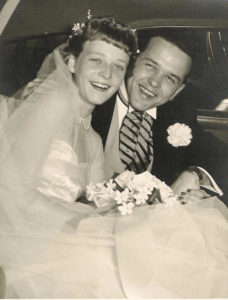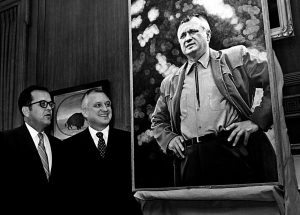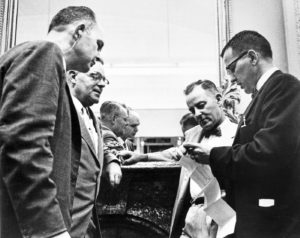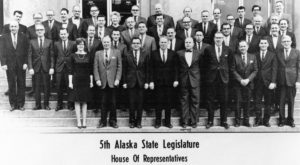Ted Stevens Achievement Timeline
Nov. 18, 1923 – Born Theodore Fulton Stevens in Indianapolis to Gertrude S. and George A. Stevens. He was one of four children.
 1938 – Moves to southern California to live with his aunt and uncle in Manhattan Beach.
1938 – Moves to southern California to live with his aunt and uncle in Manhattan Beach.
 1942 – Graduates from Redondo Union High School, Redondo Beach, Calif. Stevens participated in extracurricular activities including the school newspaper, the student theater group, a service society affiliated with the YMCA, and, during his senior year, the Lettermen’s Society. During his school years in California, he developed a passion for surfing and swimming.
1942 – Graduates from Redondo Union High School, Redondo Beach, Calif. Stevens participated in extracurricular activities including the school newspaper, the student theater group, a service society affiliated with the YMCA, and, during his senior year, the Lettermen’s Society. During his school years in California, he developed a passion for surfing and swimming.
![Ted Stevens[1]](https://tedstevensfoundation.org/wp-content/uploads/2015/02/Ted-Stevens1-199x300.jpg) 1942- Enrolls at Oregon State University to study engineering. He attends for one semester, but with World War II in progress, he applies to the Army.
1942- Enrolls at Oregon State University to study engineering. He attends for one semester, but with World War II in progress, he applies to the Army.
1943 – Enrolls at Montana State College for Army Air Corps cadet training; joins Army Air Corps in Santa Ana, Calif.
1944- Scoring near the top of an aptitude test for flight training, Stevens was transferred to preflight training at Ryan Airfield in Tuscon, Arizona; and received his wings early in 1944.
1944-46 Serves as transport pilot flying C-46s and C-47s in support of the “Flying Tigers” in China-Burma-India Theater during World War II; awarded 2 Distinguished Flying Crosses and other decorations for his skill and bravery.
1947 – Graduates from UCLA with a B.A. in political science. While at UCLA, he was a member of Delta Kappa Epsilon Fraternity.
1949 – Stevens worked as a research assistant in the office of the U.S. Attorney for the Southern District of California.
1950 – Graduates from Harvard Law School. While at Harvard, Stevens wrote a paper on water law. It became a Harvard Law review article and would later be cited in an opinion by the Alaska Supreme Court.
1950-52 – Practices law in Washington, D.C., with the firm Northcutt Ely. Stevens was assigned to handle the legal affairs of Alaskan Emil Usibelli.

1952 – Marries Ann Mary Cherrington in Denver, Colo. They have 5 children, Susan, Beth, Ted, Walter and Ben.
1953 – Ted and Ann drive to the Territory of Alaska to take a job with law firm Collins and Clasby in Fairbanks.
1954 – Named U.S. attorney in Fairbanks on March 30th. Stevens soon gained a reputation as an active prosecutor who vigorously prosecuted violations of federal and territorial liquor, drug, and prostitution laws.
1956 – Returns to Washington to work as Legislative Counsel for Interior Secretary Fred Seaton. He became known as ‘Mr. Alaska’ by the Department of the Interior because of his relentless efforts on Alaska Statehood.
1958 – Alaska Statehood Act became law on July 7th.

1959 – Alaska formally was admitted to statehood on January 3, 1959, when President Eisenhower signed the Alaska Statehood Proclamation.
1960 – Appointed Solicitor (chief lawyer) of the U.S. Department of the Interior.1961 – Opens Stevens & Roderick law firm in Anchorage
1962 – Loses U.S. Senate race to incumbent Ernest Gruening.
1964 – Wins a seat in the Alaska House of Representatives.
1966 – Re-elected to Alaska House, he became House majority leader in his second term.
 1968 – Loses U.S. Senate primary to Anchorage banker and former Mayor Elmer Rasmuson. Rasmuson loses the general election to Mike Gravel.
1968 – Loses U.S. Senate primary to Anchorage banker and former Mayor Elmer Rasmuson. Rasmuson loses the general election to Mike Gravel.
 Dec. 24, 1968 – Appointed by then Governor Walter Hickel to replace Sen. E.L. Bob Bartlett, a Democrat, after his sudden death.
Dec. 24, 1968 – Appointed by then Governor Walter Hickel to replace Sen. E.L. Bob Bartlett, a Democrat, after his sudden death.
1969 – Leads the fight to confirm Walter Hickel as Secretary of the Interior, the first Alaskan to serve in the President’s cabinet.
Nov. 3, 1970 – Wins special election with 60 percent of the vote, defeating Democrat Wendell P. Kay.
1971 – Co-sponsors an amendment to a Selective Service bill setting forth terms for the withdrawal of U.S. troops in Vietnam.
1971 – The Alaska Native Claims Settlement Act (ANCSA) was signed into law by President Richard M. Nixon on December 18,
1971. Senator Stevens was a strong supporter of settlement and worked to ensure the law resolved long-standing issues surrounding aboriginal land claims in Alaska, as well as to stimulate future economic development throughout Alaska. Rather than perpetuate the failed reservation policy in other states, this law provided 44 million acres and nearly $1 billion to thirteen regional and 200 village corporations.
1972 – Wins his first full term in 1972.
1972 – Named to the Senate Appropriations Committee; co-sponsors Title IX legislation banning sex-based discrimination in federally funded educational institutions; worked to create the Alaska bypass mail system.
1972 – Marine Mammal Protection Act. Senator Stevens secured an exemption to allow Native Alaskans to continue their subsistence and cultural way of life.
1973 – The battle over construction of the Alyeska Pipeline ends with the passage of the Trans-Alaska Pipeline Act. This bill passed the Senate by a single vote cast by the Vice President and allowed the development of the vast petroleum reserves on Alaska’s North Slope transforming the state of Alaska.
1976 – The Magnuson Fishery Conservation and Management Act signed into law (later renamed the Magnuson-Stevens Fishery Conservation and Management Act). Stevens fought hard for this legislation which created the 200 mile limit and allowed the United States to regulate fishing, ending the exploitation of the fish stocks by foreign fisherman. It established eight regional councils to manage and conserve fishery stocks.
1977-1985 – Serves as Assistant Minority Leader of the Senate.
1978 – Amateur Sports Act became law. This act developed from Stevens’ service on the Commerce Committee and a presidential commission. The Act restructured amateur sports by establishing the United States Olympic Committee as the lead entity for Olympics and providing for national governing bodies for each Olympic sport. The Act also provides important legal protection for individual athletes.
November 1978 – Wins reelection to his second full term in the Senate.
Dec. 4, 1978 – His wife, Ann, and four others perish in a plane crash at Anchorage International Airport. Stevens and Tony Motley survive.1980 – The Alaska National Interest Lands Conservation Act (ANILCA) passed on November 12, 1980 and was signed into law by President Jimmy Carter on December 2. ANILCA provided varying degrees of special protection to over 157,000,000 acres of land, including national parks, national wildlife refuges, national monuments, wild and scenic rivers, recreational areas, national forests, and conservation areas. Senator Stevens fought hard to make sure Alaska’s interests were reflected in the final version of the law.1980 – Marries Catherine Chandler, a lawyer from a prominent Democratic family, and a fourth-generation Alaskan. They have a daughter, Lily who was born in 1981.
1981 – Becomes assistant majority leader when Republicans take control of the Senate.1982 – Senator Stevens fought for the Alaska Railroad Transfer Act, which authorized the transfer of federal government ownership of the Alaska Railroad to the state of Alaska. In 1985, ownership officially transferred to the Alaska Railroad Corporation. Pictured with Ronald Reagan’s second Secretary of Transportation, Elizabeth Dole.
November 1984 – Wins reelection to his third full term by a wide margin.
1984 – Runs for Senate majority leader, but loses by three votes to Bob Dole of Kansas. He is selected head of the US Senate Arms Control Observer group which monitors arms reduction talks with the Soviet Union.
1987 – Senator Stevens secured passage of the ANCSA amendments of 1987, which addressed three unresolved issues of the original bill pertaining to stocks in Alaska Native Corporations. The amendments granted the corporations greater control over their stock by allowing a majority of stockholders to remove restrictions on stock, to grant stock to Natives born after December 18, 1971, and for ANCSA-eligible Natives who missed the original deadline. The amendments also extended in perpetuity a ban on taxation for undeveloped corporation lands.1987 – Senator Stevens secures funding to create the 210th Air Rescue Squadron and for needed mission aircraft as part of the Alaska Air National Guard after the U.S. Air Force inactivated its predecessor.
1989 – The Exxon Valdez runs aground near Valdez Alaska. Stevens leads the fight to establish new regulation to improve the safety of oil tankers culminating in the 1990 Oil Pollution Act which mandated all US flagged tankers have double bottoms to reduce the risk of a similar spill.
1990 – Wins reelection to his fourth full term.1992 – Senator Stevens secured funding for additional medical research for breast cancer. In later years, Stevens secured funding for a broader range of research into other types of cancer.
1992 – Senator Stevens created the Rural Alaska Village Grant to provide supplemental funding to the Alaska Village Safe Water program through USDA Rural Development. Since 1992, $489 million for rural water and sanitation systems have been provided through this program.
1993 – In the Omnibus Budget Reconciliation Act of 1993, Senator Stevens established an auction process for wireless spectrum, which over the years has raised billions of dollars for the federal treasury.1994 – Aleutian and Pribilof Restitution Act expanded compensation for losses suffered during World War II.1994 – Marine Mammal Protection Act Amendments of 1994 amended the Marine Mammal Protection Act with respect to the taking and importing of marine mammals to allow the issuance of permits for: scientific research, public display, photography for educational or commercial purposes, or enhancing the survival of a species or stock; or importing polar bear parts taken in sport hunts in Canada.1996 – Wins reelection to his fifth full term in the Senate.
1996 – Senator Stevens secures passage of the Coast Guard Authorization Act, which authorized appropriations for the Coast Guard. The bill included provisions for a number of important Alaska priorities including improving aids to navigation; funds for shore and offshore facilities, vessels, and aircraft; payments under the Retired Serviceman’s Family Protection and Survivor Benefit Plans, and payments for medical care of retired personnel and their dependents; alteration or removal of bridges obstructing navigation, and personnel and administrative costs associated with the Bridge Alteration Program; and environmental compliance and restoration.
1996 – Sustainable Fisheries Act is an amendment to the Magnuson-Stevens Fishery Conservation and Management Act. Senator Stevens sought to protect populations of fish that were already scarce from overexploitation and to protect species that would become scarce if overfishing continued. The amendment specifies that the National Oceanic and Atmospheric Administration (NOAA) is the governmental agency in charge of enforcing the Act.1997 – Chairs Senate Appropriations Committee from 1997-2001 and 2003-2005; directs more than $3 billion in federal money to Alaska from 1995-2008.
1998 – Senator Stevens secured passage of the American Fisheries Act (AFA), which strengthened U.S. ownership standards for fishing vessels operating in the 200 mile limit and included other provisions to better regulate and control fishing.1998 – Ted Stevens Olympic and Amateur Sports Act expanded the USOC’s role to include the Paralympic Games, increased athlete representation, eliminated requirement for amateur status, and protected the USOC against lawsuits. Picture with Bonnie Blair, Olympic Athlete in Speed Skating, and one of the most decorated athletes in Olympic history.
1998 – Senator Stevens secured funding for a pioneering telemedicine program throughout Alaska.1998 – Senator Stevens created the Denali Commission, which provides funding and assistance for infrastructure needs throughout rural Alaska at a minimum of overhead.1999 – Senator Stevens secured funds for Project Code Red, a rural firefighting system.
2000 – Named Alaskan of the Century; Stevens represented the people of the State of Alaska with distinction in the Senate for over 40 years from 1968 to 2009 and played a significant role in the transformation of the State of Alaska from an impoverished territory to a full-fledged State through the assistance he provided in building energy facilities, hospitals and clinics, roads, docks, airports, water and sewer facilities, schools, and other community facilities in the State of Alaska. Pictured is Senator Ted Stevens with wife, Catherine, his children and their families, and his sister Rosemary Stevens McMaster.
2000 – Anchorage airport is renamed Ted Stevens Anchorage International Airport.
2000 – Senator Stevens secured a $29 million, five year appropriation to combat the high rates of fetal alcohol syndrome in Alaska. The funds were allocated for prevention and treatment. Estimates show an up to 64% decrease in children born with FAS.2001 – The Ted Stevens Foundation was founded to recognize and honor the career and public service of Senator Ted Stevens of Alaska.2002 – Wins reelection to his sixth full term in the Senate2002 – Rural Service Improvement Act signed into law. It made changes sought by Senator Stevens to the bypass mail system to ensure that rural Alaskans had access to affordable food and necessities, and provided affordable passenger and freight opportunities.2003 – Stevens secured funding for a number of important Alaska projects, including Village Public Safety Officers; the Arctic Energy Office for studies on an Alaska natural gas pipeline; housing for abused women and children; telemedicine; rural airports; Village Safe Water; and funding for alcohol abuse programs.2003 – Stevens initiates the Alaska Obesity Summit to address rising obesity rates in Alaska. Funding for the State of Alaska Obesity Prevention and Control followed, with federal funds used for programs such as Healthy Futures.
2003-2007 – Serves as president pro tempore of the Senate, third in line to Presidential succession, the only Alaskan to hold an office described in the US Constitution.
2004 – Senator Stevens includes the Alaska Natural Gas Pipeline Act in the Fiscal Year 2005 Military Construction Appropriations bill. Authorized a loan guarantee and expedited provisions for federal approvals.2004 – Stevens delivered a tribute to Ronald Reagan during a memorial service at the U.S. Capitol Rotunda2006 – Stevens delivered a eulogy of Gerald R. Ford during services at the U.S. Capitol commemorating 38th President’s life.
2006 – Magnuson-Stevens Fishery Conservation and Management Reauthorization became law. It mandates the use of annual catch limits and accountability measures to end overfishing, provides for widespread market-based fishery management through limited access privilege programs, and calls for increased international cooperation.
2007 – Stevens was recognized as the longest serving Republican senator in history when his career spanned more than thirty-eight years.
2008 – Over zealous prosecutors obtained an indictment of Senator Stevens. The resulting trial was fatally tainted by multiple acts of prosecutorial misconduct which caused Attorney General Holder to instruct that the case be dismissed in April of 2009. The trial judge found there had been no conviction.
January 3, 2009 – Senator Stevens’ extraordinary career in the U. S. Senate ended. He had served over 40 years, longer than any other member of his party in history. During his service Alaska was transformed in large part because of his commitment to Alaskans through improvements in health care, communications, transportation, education, sanitation, aviation, fisheries, mining, oil and gas development and innumerable other ways.
August 10, 2010 – Senator Stevens and four others were killed in the crash of a small aircraft near Dillingham, Alaska. Four passengers survived the accident. Senator Stevens’ funeral in Anchorage was attended by thousands of Alaskans, the Vice President of the United States, dozens of members of the Senate, military leaders, and other elected officials. He was later interred at Arlington National Cemetery overlooking Washington D.C. and the United States Capitol. This service was attended by hundreds of people, including nearly all members of the United States Senate.
2011 – Ted Stevens Day – The Alaska State Legislature establishes the fourth Saturday in July as Ted Stevens Day, a day for Alaskans to “Get Out and Play” in honor of Senator Stevens.
October 27, 2011 – Honored by the Pacific Aviation Museum Pearl Harbor with a plaque and a display of memorabilia of his wartime service in China-Burma-India.
July 12, 2012 – Ted Stevens posthumously inducted into the US Olympics Hall of Fame.
October 2014 – The United States Olympic Committee dedicated a new facility at the Colorado Springs Olympic Training Center as the “Ted Stevens Sports Services Center.” Pictured is Lily Becker Stevens, and her husband, Preston Becker.




